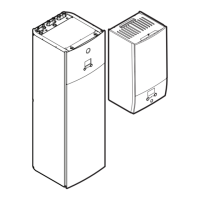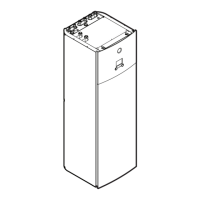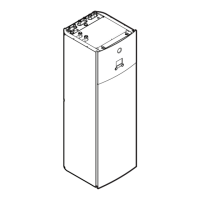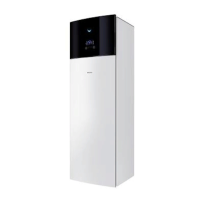Do you have a question about the Daikin EHVX08S18DA9W and is the answer not in the manual?
Details the documentation provided for installers and its purpose.
General instructions and precautions for authorized installers.
Procedures for unpacking, handling, and removing accessories from the outdoor unit.
Procedures for unpacking, handling, and removing accessories from the indoor unit.
How to identify outdoor and indoor units using their labels and model codes.
Guidance on configuring space heating and cooling systems for different room setups.
How to integrate an auxiliary boiler for space heating support.
Procedures for setting up the domestic hot water (DHW) tank, including volume and temperature.
How to calculate and select DHW tank volume and desired temperature.
How to set up energy metering using external power meters.
Setup for energy metering with a normal kWh rate power supply.
Setup for energy metering with a preferential kWh rate power supply.
How to limit the total system power consumption.
Setting a permanent power limitation for the entire system.
How to connect and configure external temperature sensors for indoor or outdoor use.
Requirements and considerations for selecting the installation site.
Specific site requirements for installing the outdoor unit, including spacing.
Special site requirements for outdoor units in cold climates, e.g., snow.
Guidelines and requirements for preparing refrigerant piping.
Specifications for piping material, diameter, and thickness.
Requirements for insulating refrigerant piping to prevent condensation.
Guidelines and requirements for preparing water piping.
Procedures for checking water volume and flow rate, and minimum flow requirements.
Instructions on how to adjust the expansion vessel pre-pressure.
General precautions and safety guidelines for electrical wiring.
Information on connecting to preferential kWh rate power supply systems.
Outlines the typical workflow and stages of system installation.
Steps and precautions for mounting the outdoor unit.
Explains the workflow for mounting the outdoor unit before connecting pipes.
How to ensure a stable and secure installation structure for the outdoor unit.
Step-by-step instructions for positioning and fixing the outdoor unit.
How to ensure proper drainage of condensation water from the outdoor unit.
Explains the workflow for mounting the indoor unit before connecting pipes.
Safety and preparatory notes before mounting the indoor unit.
Instructions for placing and leveling the indoor unit on the floor.
Detailed steps for connecting refrigerant piping.
Critical safety and handling precautions for refrigerant piping connections.
Best practices for connecting refrigerant pipes, including tools and torque.
Step-by-step guide on how to properly flare pipe ends for refrigerant connections.
Connecting refrigerant piping to the outdoor unit's stop valves.
Connecting refrigerant piping to the indoor unit's connections.
Procedures for checking refrigerant piping for leaks and performing vacuum drying.
Safety precautions and tool requirements for checking refrigerant piping.
Method for detecting refrigerant leaks using a bubble test.
Steps for performing vacuum drying to remove moisture and air from the system.
Procedures for charging refrigerant into the system.
Step-by-step instructions for charging additional refrigerant.
Safety and installation precautions for water piping.
Connecting space heating and DHW water pipes to the unit.
Detailed steps for connecting all electrical wiring.
Critical safety precautions for electrical wiring.
Best practices for installing wires and terminals.
Connecting electrical wiring to the indoor unit.
Connecting the main power supply to the unit.
Connecting the dedicated power supply for the backup heater.
How to configure the system settings after installation.
Configuration settings related to the domestic hot water tank.
Advanced settings accessible only by installers.
Essential steps for commissioning the system after configuration.
Installer settings for controlling system power consumption.
Installer settings for bivalent operation.
A checklist of items to verify before starting the commissioning process.
A checklist of tasks to perform during the commissioning process.
Ensuring the user understands system operation and maintenance.
Guidance on performing regular maintenance and service on the unit.
Safety precautions to be followed during maintenance work.
Checklist for essential yearly maintenance tasks for the indoor unit.
Guidance on diagnosing and resolving system problems.
Safety precautions to follow before and during troubleshooting.
Diagnosing issues based on observed system symptoms.
Troubleshooting steps when the unit does not heat or cool properly.
Troubleshooting steps when the compressor fails to start.
Guidance on understanding and resolving issues based on error codes.
Procedure for pumping down the system, e.g., for relocation or disposal.
Provides technical specifications and diagrams for the system components.
Diagram illustrating the piping connections for the indoor unit.
Diagram showing the electrical wiring connections for the outdoor unit.
Diagram showing the electrical wiring connections for the indoor unit.
Details the documentation provided for installers and its purpose.
General instructions and precautions for authorized installers.
Procedures for unpacking, handling, and removing accessories from the outdoor unit.
Procedures for unpacking, handling, and removing accessories from the indoor unit.
How to identify outdoor and indoor units using their labels and model codes.
Guidance on configuring space heating and cooling systems for different room setups.
How to integrate an auxiliary boiler for space heating support.
Procedures for setting up the domestic hot water (DHW) tank, including volume and temperature.
How to calculate and select DHW tank volume and desired temperature.
How to set up energy metering using external power meters.
Setup for energy metering with a normal kWh rate power supply.
Setup for energy metering with a preferential kWh rate power supply.
How to limit the total system power consumption.
Setting a permanent power limitation for the entire system.
How to connect and configure external temperature sensors for indoor or outdoor use.
Requirements and considerations for selecting the installation site.
Specific site requirements for installing the outdoor unit, including spacing.
Special site requirements for outdoor units in cold climates, e.g., snow.
Guidelines and requirements for preparing refrigerant piping.
Specifications for piping material, diameter, and thickness.
Requirements for insulating refrigerant piping to prevent condensation.
Guidelines and requirements for preparing water piping.
Procedures for checking water volume and flow rate, and minimum flow requirements.
Instructions on how to adjust the expansion vessel pre-pressure.
General precautions and safety guidelines for electrical wiring.
Information on connecting to preferential kWh rate power supply systems.
Outlines the typical workflow and stages of system installation.
Steps and precautions for mounting the outdoor unit.
Explains the workflow for mounting the outdoor unit before connecting pipes.
How to ensure a stable and secure installation structure for the outdoor unit.
Step-by-step instructions for positioning and fixing the outdoor unit.
How to ensure proper drainage of condensation water from the outdoor unit.
Explains the workflow for mounting the indoor unit before connecting pipes.
Safety and preparatory notes before mounting the indoor unit.
Instructions for placing and leveling the indoor unit on the floor.
Detailed steps for connecting refrigerant piping.
Critical safety and handling precautions for refrigerant piping connections.
Best practices for connecting refrigerant pipes, including tools and torque.
Step-by-step guide on how to properly flare pipe ends for refrigerant connections.
Connecting refrigerant piping to the outdoor unit's stop valves.
Connecting refrigerant piping to the indoor unit's connections.
Procedures for checking refrigerant piping for leaks and performing vacuum drying.
Safety precautions and tool requirements for checking refrigerant piping.
Method for detecting refrigerant leaks using a bubble test.
Steps for performing vacuum drying to remove moisture and air from the system.
Procedures for charging refrigerant into the system.
Step-by-step instructions for charging additional refrigerant.
Safety and installation precautions for water piping.
Connecting space heating and DHW water pipes to the unit.
Detailed steps for connecting all electrical wiring.
Critical safety precautions for electrical wiring.
Best practices for installing wires and terminals.
Connecting electrical wiring to the indoor unit.
Connecting the main power supply to the unit.
Connecting the dedicated power supply for the backup heater.
How to configure the system settings after installation.
Configuration settings related to the domestic hot water tank.
Advanced settings accessible only by installers.
Essential steps for commissioning the system after configuration.
Installer settings for controlling system power consumption.
Installer settings for bivalent operation.
A checklist of items to verify before starting the commissioning process.
A checklist of tasks to perform during the commissioning process.
Ensuring the user understands system operation and maintenance.
Guidance on performing regular maintenance and service on the unit.
Safety precautions to be followed during maintenance work.
Checklist for essential yearly maintenance tasks for the indoor unit.
Guidance on diagnosing and resolving system problems.
Safety precautions to follow before and during troubleshooting.
Diagnosing issues based on observed system symptoms.
Troubleshooting steps when the unit does not heat or cool properly.
Troubleshooting steps when the compressor fails to start.
Guidance on understanding and resolving issues based on error codes.
Procedure for pumping down the system, e.g., for relocation or disposal.
Provides technical specifications and diagrams for the system components.
Diagram illustrating the piping connections for the indoor unit.
Diagram showing the electrical wiring connections for the outdoor unit.
Diagram showing the electrical wiring connections for the indoor unit.
| Category | Heat Pump |
|---|---|
| Model | EHVX08S18DA9W |
| Refrigerant | R-32 |
| Operating Temperature Range (Heating) | -15°C to 24°C |
| Noise Level (Indoor Unit) | 28 dBA |












